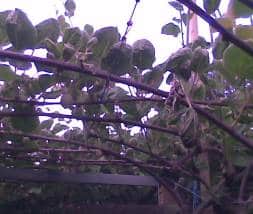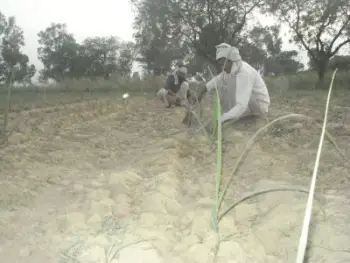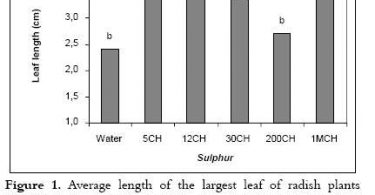Each month V.D. Kaviraj answers questions about plants and plant problems. Kaviraj is one of the foremost pioneers of Agro-homeopathy and author of the book, Homeopathy for Farm and Garden.
Send your questions! (with pictures when possible -JPG or GIF format) to [email protected] with the subject “Plant Doctor”.
Note: When I refer to treating plants with homeopathic remedies, this is the standard dosing procedure: Put 20 drops of a 6X potency in a litre of water. Succuss the bottle 50 times. Put this litre in the watering can, fill it up with 19 litres of tap water and stir. If the watering can is smaller, the amount of remedy put in must be proportionally smaller. Thus a 10 litre can needs only ½ litre and just 10 drops of the remedy. Apply the contents of the watering can to the roots of the plants to be treated.
Hi Kaviraj,
Here is the effect of using Silicea on a plant affected by hormone spray.In the past, we have had to cut back these plants, and hope they will regrow. In some cases this would work, in some we would lose the plants. I applied 10 drops of Silicea 200c in 500ml water around the roots at the trunk. Noticeable improvement in leaves, the effect of hormone damage is cupping of the leaves, which appears to spread systemically in the plant, affecting even new growth. In the treated plant you see the leaves are recovering, cupping noticeably improved, good new growth, which is unaffected. Very pleasing results.
Kind regards Shiree
Dear sir,
I keenly read your articles in ‘Ask the Plant Doctor’. I have also started some application with favourable results. Along with homoeopathic practice I have a huge mango cultivation which I have till date kept chemicals free. There is no problem in fertilizers, but the problem comes with the issue of pesticides. The Mango Hopper is difficult to remove and resistance has even started developing to the imidaclopride molecule. Please suggest some medicine for the Mango Hopper. Also, can you suggest anything which could produce flowering earlier (eg.growth regulator)?
Thank you
Dr. Madhusudan Vaidya
K: Dear Madhusudan,
Those hoppers are leaf hoppers I suppose. It would be nice if you have a photo. You could try Thuja or Coccinella, depending on whether the insects or larvae are soft bodied or not.
As for bringing plants to bloom earlier, it is comparable to a woman having her period, and that follows its own cycle. You can try Phosphorus, but I cannot guarantee anything. Farming is mainly a question of patience and let the seasons do their work.
Dear Doctor,
Some of the neem trees are having a problem. A weed started growing from the branches of the neem tree. Then slowly the branch becomes dry and dead. If the number of weeds are more, the whole tree dies. The weed grows in the land like any other tree. The weed is known as ” Manjanathi ” in Tamil. Kindly guide me to solve this problem. I have some fundamental knowledge of Homeopathy.
With Warm Regards
V.Kadal Amutham
K: Hi Kadal,
That sounds much like mistletoe, which is also known as witch’s broom. It is a parasitic plant and I can only think of the same in potency to see if it can eradicate it. Viscum album is the name of the remedy.
Dear Kaviraj,
I have two questions. My husband’s lawn tennis/football pitch (paspalum for its higher salinity tolerance ) is regularly plagued by worms ( the bright green colour becomes yellowy in patches) What to give it? – Meriem B. Laouiti
K: Dear Meriem,
Are you in a saline environment? Then you may still use natrum muriaticum. Alternatively, Silicea comes to mind, with which I had great suceess at Port Bouvard Bowling club in W Australia. But that is for the regeneration of the grass. For the worms, which I surmise are caterpillars, Sambucus or Bombyx might be the remedy. Can you send photos of both problems?
I’m very new at gardening! After many years in the UK we¹ve managed to buy a nice piece of land in our native Tunisia where we¹ve planted citrus fruits… Only the dreaded Phillocnistis citrella parasite (“la mineuse” as it’s called locally) has high-jacked the plants. Could you tell me what I can give them to fight it off?
K: Here is a brief study describing what you can use and below that I tell you where to get it and how to use it.
Biological aspects of Cirrospilus neotropicus Diez & Fidalgo (Hymenoptera: Eulophidae), parasitoid of Phyllocnistis citrella Stainton (Lepidoptera: Gracillariidae)] [Article in Portuguese] Foelkel E, Redaelli LR, Jahnke SM, Losekann PB. Depto. Fitossanidade, UFRGS, Porto Alegre, RS, 91540-000, Brazil.
Abstract
The biology of Cirrospilus neotropicus Diez & Fidalgo reared on third instar Phyllocnistis citrella Stainton larvae having Citrus limonia Osbeck as host plant, was evaluated under controlled conditions (25 +/- 1 masculineC; 12h photophase). The survival, immatures development, longevity, sex ratio, host feeding and oviposition ratio of C. neotropicus, were registered. Two groups of parasitoid females were evaluated: one, with parasitoids obtained from P. citrella pupae collected in citrus orchards and the other group came from laboratory rearing. These females, after mating, were maintained individually on gerbox containers with honey and pollen as food source. At each 48h, 12 P. citrella larvae were changed. The average biological cycle of the female progenies from orchard and laboratory generation groups were 11.8 and 11.6 days, respectively. The males progenies had biological cycles of 11.6 and 10.9 days, as well. The shortest immature survival period, for both studied groups was the larval (57.3% – orchard group and 57.4% – lab group). The mated females average longevity (21.8 days) was superior than the non mated ones (9.1 days) for the orchard group. The average daily oviposition rate for this last group was also significantly superior (2.8 eggs /day) than the lab group (1.6 eggs / day). The same trend was observed for the average daily host feeding rate (1.7 larvae /day for the orchard group and 0.9 larvae/ day for the lab group). These data suggest that C. neotropicus have potential as a biological control agent of P. citrella.
So this predator is the best on the market. You can get it from Keppel in Holland or from France maybe. There are lists of predator breeders and sellers online.
You order 2 boxes, then you have about 200 larvae. These you grind up with mortar and pestle and lactose (milk sugar) 1 part insects against 33 parts of lactose by weight, for 1 hour. Then you add another 33 parts of lactose and do another hour. Last comes the last 33 parts of lactose and you do the last hour.
Next you dissolve this in 1 litre of water, add another litre of alcohol and this is your tincture. From this you make in the decimal scale 1/10, tincture and water. Bang the bottle 10 times. Take again from that bottle 1/10 as before and repeat this process till 5X. at 6X you bang the bottle 50 times and use dilution rates as above. If you make a batch large enough, you can also sell that to the neighbours and start a business in it too. I can supply you with more remedies and you can make a good living. You would have to come and learn for about 6 months.
Success!
Dear Dr. Kaviraj,
Our query relates to Sugar Cane Farming . We develop Cane plantlets through Bud-chip method. Brief is attached in excel file. Plantlets grown is attached as JPEG file no 1. When it is distributed to the cane grower and they plant these plantlets in their field, maximum plantlets die during the month of March – April when temperature starts rising. Mortality is more than 50%. Growth % is poor as attached in jpeg no. 2.
1. Please suggest the Homoeopathic medicine which can help in Cane Farming of Bud chip method, when farmer plants these plantlets from taking out Plastic tray and tolerate atmospheric changes i.e. summer season.
2. Name of the medicine, doses, application period, during raising of plantlets in tray and after planting in field?
3. Does book by Dr. V.D. Kaviraj have any article on Sugar Cane Farming ?
With regards,
S.N.Ojha
K: Dear Mr. Ojha,
- The remedy to use here is Silicea 6X. Application rate as described in the column here at the top of the page.
- The best time to apply is during raising. A second application can be given – when necessary – after planting in the field of Calendula 6X, for transplant shock.
- My book has no chapters on Sugarcane planting and growing. My book has chapters on the remedies, which are applicable to all plants.
Dear sir,
1. Instead of NPK fertilizers what should be used?
2. Can I use homeopathic medicines along with other chemical pesticides, fungicides?
With warm regards,
Prashant A. Raut – Pune
K : Hi Prasant,
Instead of chemical fertilisers, the best is to use cow dung and other organic material. The soil needs to be enriched with as much organic material as you can put on – straw, pea-straw, leaves, compost etc.
If you use homoeopathic medicines while you also use chemical pesticides, what can you learn? You will never know if the remedy has worked. Do you always mop the floor while the tap is running? The remedies were developed to finally stop using poisons, which are no good for the environment, no good for you, and no good for your produce. Do you think that growing, selling and eating poisoned food is a good idea?










DEAR SIR I HAVE A SMALL MINI KITCHEN GARDEN IN MY HOUSE MY ALL PLANTS DIE WITH ROOT TUMERS AND SOME TIME THEIR BRANCHES AND THE HOLE PLANT AND ROOTS ARE GANGERENE TYPE SYMPTEMS SO SIR PLEASE SUGGEST ME WHAT I DO.I READ HOMEOPTHY LAST 10 YEARS AND I WANT TO KNOW MORE ABT PLANTS MEDISONS AND A BOOK TOO.
Sir,
1) How much time silicea spray for annual crops,6 months crops, 3 months crops?
2) what happened in excess doses applied for silicea? (250 ml/acre, 500ml/acre)
3) Silicea spray, how much period taken for developed the soil?
Thanks Doctor,
thiyagaraj
hey, I am also having the same quesyions in my mind , if u got the answers pl, convey it to me pl.
Hi Prashant A. Raut – Pune, please send your email ID. I have gathered some articles I want to convey to you.
[email protected]
Hi Prashant A. Raut – Pune, please send your email ID. I have gathered some articles I want to convey to you – [email protected]
Dear Dr
I´m a student, i want to make a nosode from a plant with virus, but i´m interresting how to do the pure experimentation in plants of the same species
Dear Doctor,
How to make nutrient solution (NPK +Micro and Macro nutrients) for Hydroponics (using Cocopeat as a media) with homoeopathic ingredients instead of expensive chemicals? Pl advice.
Avinash
Sir,
which remedies can use for the coconuts tree?
and aqatics remedes. eg. prowns, how does the remedy prepare?
thanks.
Dr. Kaviraj,
The service that you are rendering is not to the individuals concerned but to humanity at large. The chemicals used by one and sundry for prevention or elimination of the plant disease were causing unimaginable destruction on the well being of the human race.
Thank you and God bless you.
Sir,
I have very small garden. I have 2 Coconut trees which is 7 years old. The yielding of coconuts is since one year. Yielding was very little. For more yielding & also to save from pests, which homeo medicine do you suggest & in what frequency. I have very few flowering plants. What do you suggest for yielding more flowers and also to protect them from pests like caterpillar.
Thanking you
Veena Vishnumurthy
I have much regard for use of homeopathy on plants. I like articles on this subject.
Thanks to Dr. Kaviraj for his advice on plant homeo treatment. I aften try follow his advice. Further, it is a sort of organic farming practice.
I am a Vet, currently on farm practiceand take up Veg crop cultivation. I tried preparation of nosodes by grinding diseased plant material and potentizing with surgical spirit (Since ethnol is a restricted chemi in India)upto 6th to 12th potency.
i am growing tomatoes and gherkins and roses. I have problem with small green bugs early in summer and then caterpillars late at end of summer.Would you know what remedy(s) I could use to control this problem. Thank you Leon